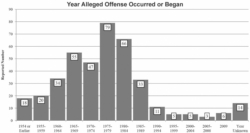A safer place
Many of us remember well what has been referred to as “the long Lent of 2002” and, as we begin this most Holy Week of the year, it looks as if we may be facing a “long Lent” of 2010.
Recent revelations of sexual abuse by priests in Europe are bringing back memories of our own crisis, which rocked the Church in Boston and the United States in 2002.
We are confronted again by the all too familiar stories of children being preyed upon by serial abusers and a culture of self-protection in the Church.
As we often noted during our own crisis, there is no way to effectively root out this problem other than placing the protection of our children first. The gravity of the offense requires nothing less. When a child is sexually abused by a person in a position of authority, similar in many ways to a father figure, the damage is severe and lifelong. Indeed, not all victims have been able to survive it.
As we watch the media coverage coming out of Europe, we should note that we here in Boston can say that our Church is currently providing a much safer environment for children than it did 20 years ago. Since the bishops first addressed the issue in 1993, and then even more forcefully in 2002 by enacting the “Charter for the Protection of Children and Young People,” the steps they have taken have had a tremendous effect in protecting our children.
The Charter requires the dioceses in the United States:
To create a safe environment for children,
To provide assistance to victims of abuse,
To respond promptly to allegations,
To report cases of abuse and encourage victims to do the same,
To remove from ecclesial ministry all clergy found responsible of even one incident of abuse.
Most importantly, the Charter calls for sustained accountability. For the last seven years, audits requested by the bishops have examined dioceses’ compliance with the Charter. The data of the most recent audit, published just last month, is encouraging. The vast majority of dioceses -- including Boston -- were found to be in compliance with the Charter. In another reassuring finding, the number of abuse cases reported during the audit period declined by about one-third from one year before.
It is important to note that the vast majority of even those cases newly reported in 2009 are alleged to have occurred decades ago.
The report reads:
“For the majority of new allegations (71 percent), the abuse occurred or began between 1960 and 1984. The most common time period for allegations reported in 2009 was 1975-1979. This is approximately the same time pattern that has been reported in previous years, with most allegations reportedly occurring or beginning between the mid-1960s and the mid-1980s. For 14 new allegations reported in 2009 (4 percent), no time frame for the alleged abuse could be determined by the allegation.”
The fact that even one child is harmed by abuse is troubling. However, no reasonable person can deny that the Archdiocese of Boston, where revelations of abuse sparked a national crisis in 2002, is a safer place today. Yet the crisis is not over and in a sense, we should never consider it over, just as our commitment to protecting our children from abuse should be never-ending.



















